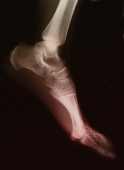
FRIDAY, July 22 (HealthDay News) — Ancient footprints of a human ancestor found in Tanzania show human-like walking began 3.7 million years ago, according to new research.
The footprints demonstrate that the fully upright gait of modern humans existed about 2 million years earlier than previously thought, said researchers at the University of Liverpool.
“The shape of the human foot is probably one of the most obvious differences between us and our nearest living relatives, the great apes. The difference in foot function is thought to be linked to the fact that humans spend all of their time on the ground, but there has been a lot of debate as to when in the fossil record these changes occurred. Our work shows that there is considerably more functional overlap than previously expected,” Bill Sellers, of the University of Manchester’s Faculty of Life Sciences, said in a University of Liverpool news release.
Known as the Laetoli trail, the 11 individual footprints found in Tanzania are the earliest known footprints made by human ancestors. The prints reveal features of a gait with more similarities to the way modern humans walk than the bipedal walking of chimpanzees, orangutans and gorillas.
In conducting the study, the researchers used statistical and imaging techniques to obtain a three-dimensional average of the 11 footprints and compared the results to data from previous studies on footprint formation and under-foot pressure in modern humans and other living great apes. Then they used computer simulation to predict how Australopithecus afarensis — the species that left the Laetoli trail footprints — walked.
“It was previously thought that Australopithecus afarensis walked in a crouched posture, and on the side of the foot, pushing off the ground with the middle part of the foot, as today’s great apes do,” Robin Crompton, professor at the University of Liverpool’s Institute of Ageing and Chronic Disease, explained in the news release.
“We found, however, that the Laetoli prints represented a type of bipedal walking that was fully upright and driven by the front of the foot, particularly the big toe, much like humans today, and quite different to bipedal walking of chimpanzees and other apes,” Crompton added.
The study authors noted that the findings are particularly important because the development of the features of human foot function helped human ancestors branch out of Africa.
“Our work demonstrates that many of these features evolved nearly 4 million years ago in a species that most consider to be partially tree-dwelling. These findings show support for a previous study at Liverpool that showed upright bipedal walking originally evolved in a tree-living ancestor of living great apes and humans. Australopithecus afarensis, however, was not modern in body proportions of the limbs and torso,” Crompton noted.
Australopithecus afarensis had the reverse physical build of modern humans — short legs and a long body. As a result, the researchers said, this species could only walk or run well for short distances. Additional studies are needed to determine when human ancestors became able to walk or run over very long distances, enabling them to colonize the world.
The findings were released online July 20 in advance of publication in an upcoming print issue of Interface.
More information
The U.S. National Academy of Sciences provides more information on evolution.

